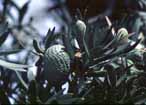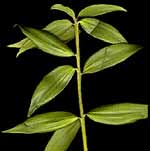
Cone and foliage on a tree in the Los Angeles County Arboretum [C.J. Earle, 12-Mar-1998].
Common Names
Queensland kauri, smooth-bark kauri (2), kauri pine (3).Taxonomic notes
Some authorities (2) segregate the Fraser Island population as A. robusta and refer to the northern populations as A. palmerstonii. Basionym: Dammara robusta F. Muell. 1860 (3). Variety nesophila Whitm. 1980, was described from New Guinea but placed in synonymy by de Laubenfels (1988).Description
Tree: Monoecious tree to 50 m tall and 180 cm dbh; trunk straight with little taper, clear for over half its length; crown dense (2).Bark: Orange-brown, brown or grey-brown; smooth to slightly flaky. Inner bark mixed red, pink and brown; bark exudate clear or somewhat milky (3).
Branches:
Shoots: Two types, primary (from the branch) and lateral, diverging from primary shoots.
Leaves: Spirally arranged on primary shoots, opposite to subopposite on lateral shoots; leaves entire on petioles 3-10 mm long, linear to elliptic, 5-13 × 1-4 cm, stiff; veins fine, longitudinal, more or less parallel. Juvenile leaves similar but oblong-lanceolate, acute, 6-7 × 1-2 cm, glabrous, green, shiny above and dull beneath, venation faint and longitudinal. Cotyledons 2, almost sessile, oblong or ovate, 3-4 × 1-1.5 cm; veins fine, indistinct, longitudinal, more or less parallel (3).
Cones: Globular to cylindric, 9-15 × 8-10.5 cm (3).
Cone scales: Number 340-440, with those from the equatorial section 3.4-4.1 × 3.9-4.6 cm (3).
Pollen cones: Shortly pedunculate or almost sessile, usually axillary on slender leafy twigs, cylindric, 4-8.5(10) × 0.7-0.9 cm at maturity, bearing 600-1300 microsporophylls, each with 2-8 pollen sacs on the underside. Maturity July-September (3).
Seeds: Narrowly cordate, winged.
Wood: Creamy white to pale brown, similar to that of A. microstachya but with a density of 435-480 kg m-3. Sapwood and heartwood difficult to distinguish (2, 3).
Similar species: The smooth bark, large male strobili with 600-1300 scales, and large cones with 340-440 scales distinguish this species from others of Agathis (3).
Range
Australia: found in two disjunct areas, one in S Queensland between Tewantin and Maryborough (mainland) and on Fraser Island [latitude 25°-26.5° S]; the other in N Queensland between the Herbert River and Big Tableland near Cooktown [latitude 15.5°-18.5° S]. It grows from near sea level to (in the N) 900 m. The northern distribution is humid tropical; the mean January maximum temperature is 30-32° C and the mean July minimum 13-19° C. The southern distribution is humid subtropical with January and July temperatures of ca. 30-32° C and 6-8° C respectively. Annual precipitation is ca. 1100-1800 mm, summer-wet; rainfall in the driest month (August or September) is 25-35 mm. Soils are deep, well-drained, developed on sand dunes (Fraser Island), basalt, metamorphic or granite rocks; the species develops best on the latter (3).The species grows as a rainforest emergent and is dominant in dry marginal rainforest types. There are many associated rainforest trees, including in the northern part of its range hickory ash (Flindersia ifflaiana), silver ash (F. schottiana), brown tulip oak (Argyrodendron polyandrum), mararie (Pseudoweinmannia lachnocarpa), flame tree (Brachychiton acerifolius), stony backhousia (Backhousia hughesii), cadaga (Eucalyptus torelliana), candle nut (Aleurites moluccana) and Rhodamnia costata. In its southern range, it may be found with silver ash, mararie, flame tree, iron wood (Backhousia myrtifolia), Bennet's ash (Flindersia bennettiana) and brown malletwood (Rhodamnia trinervia) (3).
Big Tree
Oldest
Dendrochronology
"[T]rees growing in a seasonal tropical climate in north Queensland produce latewood during cooler and drier periods. Vascular cambium growth rates fluctuate, and slow-growing trees temporarily have inactive cambium around parts of the trunk so no growth ring is formed. Radiocarbon dates on old Agathis trees indicate that the frequency of ring formation is less than annual" (5).Ethnobotany
"Because of the size of the trunk it was possible to obtain fairly wide boards.Very even texture. Seasons very readily with little movement. Not durable in contact with the ground, but otherwise stands up to exposure quite well. Easy to work and can be finished to a beautiful glossy surface. Stains and polishes well. Uses: Plywood, cabinet work, furniture, indoor fittings, boat building, turning. In early homes was used for kitchen sinks and bench tops, cutting boards, flooring."Availability: Almost completely cut out, and does not perform well in plantations" (2).
Observations
Can be seen on Fraser Island or in the Lake Barrine area at Crater Lakes National Park in North Queensland.Remarks
Citations
(1) Silba 1986.(2) Keith Newbury on the WoodLink VWA Homepage.
(3) Boland et al. 1985.
(4) Resource Biology page at ANU.
(5) Ash, J. 1983. Growth rings in Agathis robusta and Araucaria cunninghamii from tropical Australia. Australian Journal of Botany 31:269-275.
[Agathis] [Araucariaceae] [home]
This page is from the Gymnosperm Database
URL: http://www.geocities.com/~earlecj/ar/ag/robusta.htm
Edited by Christopher J. Earle
E-mail:earlecj@earthlink.com
Last modified on 20-Mar-1999
